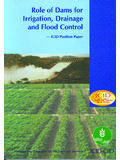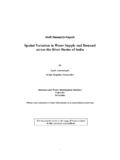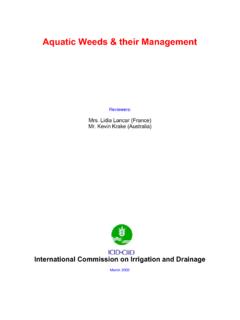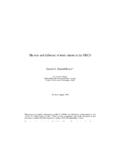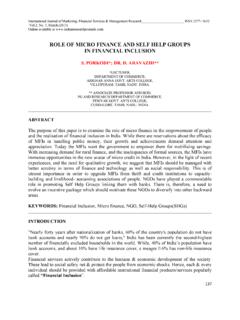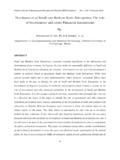Transcription of Role of Dams for Irrigation, Drainage and Flood Control
1 Dams andstakeholders2 Dams - large and smallAlthough dams have been built in the world since timesimmemorial, large dam construction was earlier notpossible though needed, because of lack of adequatedesign knowledge, construction equipment, newmaterials like cement and concrete and technology ofconstruction. Also, economic conditions and institutionalcapacity existing in countries that needed large dams,did not enable them to take them up. The large damconstruction became possible during the 20th centurymainly because of advances made in Science andTechnology, which enabled mechanisation ofconstruction processes and speedier design procedures and new constructionmaterials enabled the design of larger dams and theircomponents to take on much higher loads and , the needy countries had mobilised finances andbuilt up their capacity by then. Large dams, distinct fromsmaller ones, enable larger storage of water at suitableplaces, thus saving on multiplicity of efforts which wouldbe needed to construct several smaller ones.
2 Largerwater storages were also found to be necessary by thesociety in response to the needs of the growing urbanand industrial centres, generation of hydropower or foragricultural stakeholdersThe large dams enable harnessing of large waterresources potentials, where and when available, tomeet needs of fast growing societies round the world:food, fodder, fish production (aquaculture), drinkingwater, clothing fibres, sanitation, energy, industry, wildlifeand others. After several decades of evolving damconstruction activity, even today s needs are far fromsatisfied in many developing regions. These people ofthe world comprising, farmers who grow food; industries,municipal institutions who use water stored behind thedams, besides the governments who promote waterresources development (WRD) are major stakeholdersin dams which have been so far built. The need for moredams, especially in developing regions of the world, isstill enormous.
3 Societies for whom these dams arecrucial for existence have therefore to be considered asthe most important dams, distinct fromsmaller ones, enable largerstorage of water at suitableplaces, thus saving onmultiplicity of efforts whichwould be needed to constructseveral smaller peoplePlans and efforts have been made during the last 2 - 3decades to see that the people that are adverselyaffected due to dams are involved in the developmentprocess and are treated as stakeholders. However,there are people and organisations who feel stronglythat not enough is being done by governments andsociety while building dams to mitigate their hardshipsand conserve or improve the environment and affected people, undoubtedly, have to be consideredmajor stakeholders alongwith those who are benefitedfrom the builders, funding agencies and professionalsThe planners and builders of dams, users of water,supported by sociologists, economists, politicians whopromote dams form another group of are several associations of these majors of such world bodies are :* International Commission on Large Dams(ICOLD) established in 1928;* International Commission on irrigation andDrainage (ICID) established in 1950.
4 * International Hydropower Association (IHA)established in are some 10 similar world-wide associations ofprofessionals dealing with some of the aspects of damswhich can extend help in the matter, wherever (1998) the World Commission on Dams (WCD)has been irrigated agriculture, Drainage of rainfedcrops and of irrigated land, and Flood Control andmanagement - comprise the main action thrusts of theICID. All these are directed to ensure continued foodsecurity through improvement and extension of irrigatedand drained areas, increase in productivity andtransformation of the rural development scenariothroughout the world. A recent report from theAfter several decades ofevolving dam constructionactivity, even today s needsare far from satisfied inmany developing affected people,undoubtedly, have to beconsidered majorstakeholders alongwith thosewho are benefited from Water Management Institute (IWMI)indicates that even with best irrigation efficiency, theworld needs an extension of irrigated areas by buildingmore dams and storages.
5 To achieve these objectives,ICID acts through its country membership, which atpresent includes 87 countries. Together they accountfor 95% of the total irrigated area which contributesabout 40% of the world food production. It has morethan 25 work bodies comprising international expertsdealing with some of the issues related to the role ofdams for irrigation , Drainage and Flood Control . Thethemes covered by these bodies include EnvironmentalImpacts of irrigation , Drainage and Flood ControlProjects, Socio-economic Impacts and Policy Issues,Research and Development, irrigation and DrainagePerformance, Sustainable Use of Natural Resourcesfor Crop Production, etc. The ICID gathers world wideexperience through these work bodies, draws lessonsand builds them in its strategy for future aims to provide better management for theagricultural lands of the world through the application ofscience and techniques of irrigation , Drainage and floodcontrol measures.
6 In pursuing its aims, ICID embracesthe sound principles of socio-economic values andenvironmental management. The welfare of the peopleand preservation of nature are at the heart of it sconcerns. Dams of all sizes - small, medium and largeare an essential component of overall and integratedwater management systems. They divert water, theyretain it over long periods of time to use it effectively andthey attenuate floods and alleviate impacts of relieve Drainage congestion, and they provide forthe timely and continuous supply of irrigation waterneeded to meet the demands of crops and and new dams will continue to play a major rolein the management irrigatedagriculture, Drainage ofrainfed crops and ofirrigated land and floodcontrol and managementcomprise the main actionthrusts of the pursuing its aims, ICID embraces the soundprinciples of socio-economicvalues and Backgroundon Dams6 Large damsUnder what situations large storages are necessaryand feasible for promoting irrigation , Drainage or floodcontrol vary according to agroclimatic setting.
7 All damsstore behind them Flood -waters, primarily for the benefitof human beings. ICOLD defines large dams as thosemore than 15 m in height, while including smaller damsup to 10 m height as well, if they are otherwise significantwith respect to storage volume, density of population,etc. The classification is notional. But because of theeffects of scale the larger a dam is, the lower will be thecost of a unit of water and sizeThe storage of water enables removal of mismatchbetween variable availability and supply, but usuallymore is demanded round the year. For this purpose,many reservoirs are designed to carry over storage tothe next season as well. The variability, if not taken careof by such storages, results in droughts and/or dams - large and small and mega to micro, amelioratesuch conditions and serve similar purposes. All damsfacilitate transport of water to deficit areas by means ofopen canals, tunnels or closed pipelines.
8 In a riverbasin, a judicious combination of large and small damsmay be required to store water for facilitating withdrawaland use with minimum transport distance to demandregions. The choice of large or small dams and locationfor each dam depends on several factors includingtechnical feasibility, location of water deficit regions thatneed to be serviced and alternatives available for thepurpose. Besides, the balance of advantages anddisadvantages due to a particular dam in socio-economic and environmental aspects helps in and quantities for beneficial usesNot all the water stored behind dams is withdrawn foruse. A top depth varying from 1 to 2 meters dependingon local climate, is annually lost to atmosphere due toevaporation. At the bottom, some depth serves as adead storage for accommodating sediment brought inStorages provide insuranceagainst uncertainty due toclimatic variability, can helpreduce variability in season slow flows in rivers andbasically save societies fromeconomic upheavals andlosses due to Flood inflow.
9 Similarly some silt does accumulate in higherreaches where inflows merge into the reservoirperiphery, gradually building up small deltas of crests obviate this loss of storage to a significantextent by allowing opening of gates when inflows containhigher levels of sediment. The remaining volume minusthe seepage from the bed of the reservoir and thatacross the dam foundation and body, is available fortransport and supply for different beneficial uses. Deadstorage size depends upon the catchment areacharacteristics but similar to evaporation losses, tendsto be proportionately more in case of a smaller provide insurance against uncertainty due toclimatic variability, can help reduce variability in season slow flows in rivers and basically save societies fromeconomic upheavals and losses due to Flood dam causes partly temporary and partlypermanent submergence of land in the upstream anddisplacement of resident persons and their propertygenerally, along-with submergence of plant life anddisruption to animal life.
10 As reservoir levels recede, thesubmerged land - rich with fertile soil and silt depositscan produce valuable crops. Also downstream of dams,such effects are caused by ancillary facilities on asimilar but much smaller scale. The consequent socialand economic loss is generally assessed and comparedwith benefits due to the dam. The downstream uses aremet with mostly from flow by gravity or regulatedreleases into the river, whereas in the upstream, liftingof water is these disadvantages have to be assessed in advanceto plan ameliorative measures. During implementationof the plan and during operation, each disadvantagecalls for careful management and for irrigationA major portion of water stored behind dams in theworld is withdrawn for irrigation which mostly comprisesconsumptive use, that is, evapotranspiration (ET) needsAll the disadvantages ofdams have to be assessed inadvance to plan irrigated crops and plantations.
